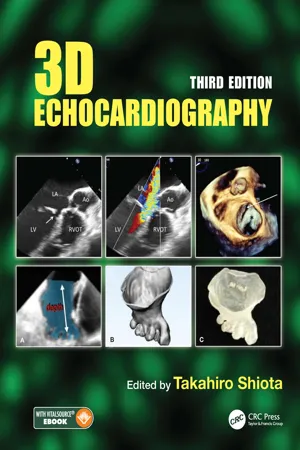
- 298 pages
- English
- ePUB (mobile friendly)
- Available on iOS & Android
3D Echocardiography
About this book
Since the publication of the second edition of this volume, 3D echocardiography has penetrated the clinical arena and become an indispensable tool for patient care. The previous edition, which was highly commended at the British Medical Book Awards, has been updated with recent publications and improved images. This third edition has added important new topics such as 3D Printing, Surgical and Transcatheter Management, Artificial Valves, and Infective Endocarditis.
The book begins by describing the principles of 3D echocardiography, then proceeds to discuss its application to the imaging of
• Left and Right Ventricle, Stress Echocardiography
• Left Atrium, Hypertrophic Cardiomyopathy
• Mitral Regurgitation with Surgical and Nonsurgical Procedures
• Mitral Stenosis and Percutaneous Mitral Valvuloplasty
• Aortic Stenosis with TAVI / TAVR
• Aortic and Tricuspid Regurgitation
• Adult Congenital Heart Disease, Aorta
• Speckle Tracking, Cardiac Masses, Atrial Fibrillation
KEY FEATURES
- In-depth clinical experiences of the use of 3D/2D echo by world experts
- Latest findings to demonstrate clinical values of 3D over 2D echo
- One-click view of 263 innovative videos and 352 high-resolution 3D/2D color images in a supplemental eBook.
Frequently asked questions
- Essential is ideal for learners and professionals who enjoy exploring a wide range of subjects. Access the Essential Library with 800,000+ trusted titles and best-sellers across business, personal growth, and the humanities. Includes unlimited reading time and Standard Read Aloud voice.
- Complete: Perfect for advanced learners and researchers needing full, unrestricted access. Unlock 1.4M+ books across hundreds of subjects, including academic and specialized titles. The Complete Plan also includes advanced features like Premium Read Aloud and Research Assistant.
Please note we cannot support devices running on iOS 13 and Android 7 or earlier. Learn more about using the app.
Information
Table of contents
- Cover
- Title Page
- Copyright Page
- Contents
- Preface to the first edition
- Preface to the second edition
- Preface to the third edition
- Acknowledgments
- Editor
- Contributors
- Abbreviations
- Chapter 1: Principles of 3D Echocardiographic Imaging
- Chapter 2: Left Ventricle
- Chapter 3: Stress Echocardiography
- Chapter 4 Right Ventricle
- Chapter 5: Left Atrium
- Chapter 6: Hypertrophic Cardiomyopathy
- Chapter 7A: Primary Mitral Regurgitation
- Chapter 7B: Secondary Mitral Regurgitation
- Chapter 8: Mitral Stenosis
- Chapter 9: Aortic Stenosis
- Chapter 10: Aortic Regurgitation
- Chapter 11: Tricuspid Regurgitation
- Chapter 12: Infective Endocarditis
- Chapter 13: Surgical Management
- Chapter 14: Nonsurgical Transcatheter Treatment
- Chapter 15: Artificial Valves
- Chapter 16: Adult Congenital Heart Disease
- Chapter 17: Aorta
- Chapter 18A: Speckle Tracking
- Chapter 18B: Tissue Tracking
- Chapter 19: Cardiac Masses
- Chapter 20: Atrial Fibrillation
- Chapter 21: 3D Printing
- Index